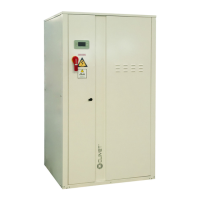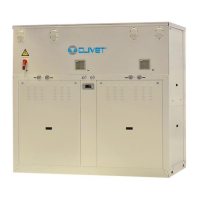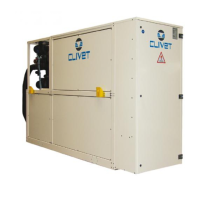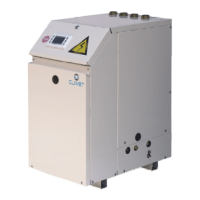Do you have a question about the CLIVET WSH-XEE2 27.2 and is the answer not in the manual?
Provides correct unit installation, use, and maintenance instructions. Emphasizes attention to warnings.
Specifies that only qualified personnel can operate the unit as per regulations.
Highlights potential risks during unit operation and emphasizes careful reading of sections for safety.
Covers installation requirements, including positioning, hydraulic, electrics, and air ducting considerations.
Instructs to disable the unit immediately and contact authorized service agents in case of breakdown.
Details the installer's role in training the user on unit operation, set points, and maintenance.
Provides a step-by-step guide for safely handling and lifting the unit, emphasizing critical points.
Outlines criteria for choosing the installation place, including fixed positions and vibration limits.
Specifies water quality requirements and the impact of inadequate characteristics on unit performance.
Details the process of making hydraulic connections, including union installation and pipe connections.
Explains the necessity of a flow switch for unit shutdown if water circulation is interrupted.
Details the step-by-step procedure for filling and operating the hydraulic circuit.
Provides instructions for making electrical connections, verifying supply, and ensuring safety.
Explains how to connect a PC to the unit for configuration and control, including network setup.
Covers Modbus/RS485 communication requirements, cable specifications, and network setup.
Outlines that start-up operations require qualified technicians and agreement on start-up data.
Lists essential preliminary checks before unit power-on, including safety, functional spaces, and electrical setup.
Details the step-by-step sequence for unit start-up, covering power supply, circuit checks, and parameter settings.
Provides checks for the refrigeration circuit, including oil presence, pressure, and valve status.
Details checks for the water circuit, ensuring it's clean, filled, pressurized, and free of air.
Covers checks for the electric circuit, including grounding, conductor tightness, voltage, and phase balance.
Explains how to limit absorbed electric power using an external signal, accessible via password.
Details how to configure climatic text correction for setpoint adjustments based on temperature curves.
Explains water reset correction effect on setpoint defined by Climate TExt, accessible via password.
Guides users on how to modify setpoints for cooling, heating, and hot water, including remote switch options.
Provides instructions on identifying alarm causes, resetting alarms, and managing alarms via password.
Lists various alarm codes (e.g., eE0001, EE0055) and their corresponding fault descriptions.
Emphasizes that maintenance must be performed by authorized centers or qualified personnel.
Highlights risks from incorrect installation, such as leaks, electric shock, or poor operation.
Details risks associated with electrical connections, grounding, and contact with live parts.
Addresses risks from refrigerant expulsion, leaks, and potential explosions or fires from heat sources.
Provides correct unit installation, use, and maintenance instructions. Emphasizes attention to warnings.
Specifies that only qualified personnel can operate the unit as per regulations.
Highlights potential risks during unit operation and emphasizes careful reading of sections for safety.
Covers installation requirements, including positioning, hydraulic, electrics, and air ducting considerations.
Instructs to disable the unit immediately and contact authorized service agents in case of breakdown.
Details the installer's role in training the user on unit operation, set points, and maintenance.
Provides a step-by-step guide for safely handling and lifting the unit, emphasizing critical points.
Outlines criteria for choosing the installation place, including fixed positions and vibration limits.
Specifies water quality requirements and the impact of inadequate characteristics on unit performance.
Details the process of making hydraulic connections, including union installation and pipe connections.
Explains the necessity of a flow switch for unit shutdown if water circulation is interrupted.
Details the step-by-step procedure for filling and operating the hydraulic circuit.
Provides instructions for making electrical connections, verifying supply, and ensuring safety.
Explains how to connect a PC to the unit for configuration and control, including network setup.
Covers Modbus/RS485 communication requirements, cable specifications, and network setup.
Outlines that start-up operations require qualified technicians and agreement on start-up data.
Lists essential preliminary checks before unit power-on, including safety, functional spaces, and electrical setup.
Details the step-by-step sequence for unit start-up, covering power supply, circuit checks, and parameter settings.
Provides checks for the refrigeration circuit, including oil presence, pressure, and valve status.
Details checks for the water circuit, ensuring it's clean, filled, pressurized, and free of air.
Covers checks for the electric circuit, including grounding, conductor tightness, voltage, and phase balance.
Explains how to limit absorbed electric power using an external signal, accessible via password.
Details how to configure climatic text correction for setpoint adjustments based on temperature curves.
Explains water reset correction effect on setpoint defined by Climate TExt, accessible via password.
Guides users on how to modify setpoints for cooling, heating, and hot water, including remote switch options.
Provides instructions on identifying alarm causes, resetting alarms, and managing alarms via password.
Lists various alarm codes (e.g., eE0001, EE0055) and their corresponding fault descriptions.
Emphasizes that maintenance must be performed by authorized centers or qualified personnel.
Highlights risks from incorrect installation, such as leaks, electric shock, or poor operation.
Details risks associated with electrical connections, grounding, and contact with live parts.
Addresses risks from refrigerant expulsion, leaks, and potential explosions or fires from heat sources.











